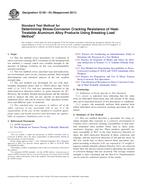Potřebujeme váš souhlas k využití jednotlivých dat, aby se vám mimo jiné mohly ukazovat informace týkající se vašich zájmů. Souhlas udělíte kliknutím na tlačítko „OK“.
ASTM G139-05(2011)
Standard Test Method for Determining Stress-Corrosion Cracking Resistance of Heat-Treatable Aluminum Alloy Products Using Breaking Load Method
Automaticky přeložený název:
Standardní zkušební metoda pro stanovení Stress korozi praskání Odolnost tepelně zpracovatelné výrobků z hliníkové slitiny Použití Breaking metody Load
NORMA vydána dne 1.9.2011
Informace o normě:
Označení normy: ASTM G139-05(2011)
Poznámka: NEPLATNÁ
Datum vydání normy: 1.9.2011
Kód zboží: NS-57376
Počet stran: 10
Přibližná hmotnost: 30 g (0.07 liber)
Země: Americká technická norma
Kategorie: Technické normy ASTM
Anotace textu normy ASTM G139-05(2011) :
Keywords:
alternate immersion, aluminum alloys, corrosion, heat-treatable aluminum alloys, outdoor exposure, residual strength, SCC, stress-corrosion cracking, tension testing: Aluminum alloys--corrosion testing, Breaking load method, Corrosion--Al/Al alloys, Heat-treated aluminum alloys, Stress corrosion cracking (SCC), ICS Number Code 77.040.10 (Mechanical testing of metals), 77.150.10 (Aluminium products)
Doplňující informace
| Significance and Use | ||||||||||||
|
The test method was developed for use with high strength aluminum alloys (2XXX and Cu containing 7XXX) that are normally tested in 3.5 weight % NaCl by alternate immersion. However, the concept which uses residual strength as a measure of damage evolution (in this case environmentally-assisted cracking) can, in principle, be applied to any alloy and environmental system. This test method has been developed for research studies of alloys and tempers with improved resistance to SCC. The test results permit different material variants to be compared with a high degree of confidence and with much more precision than the results of pass/fail tests. Thus, it is particularly useful for comparing materials with similar levels of resistance to stress-corrosion cracking. The procedure could be modified for use as a quality assurance tool but this has not been a primary purpose during its development. The exposure periods and conditions that are described in this test method apply specifically to high strength aluminum alloys, but the statistical techniques should be valid for other alloy systems with different exposure conditions. Although this particular procedure was primarily intended for testing products in the short-transverse stressing direction, it is useful for other stressing directions, particularly the long-transverse direction in sheet and thin plate products. Determination of the actual serviceability of a material requires stress-corrosion testing performed in the intended service environment, under conditions relating to the end use, including protective measures such as coatings and inhibitors and is outside the scope of this test method. There is no good way to compare test environments to actual service because most service environments have large inherent variability with respect to a single structure that may experience many different environments or with respect to two identical structures that serve in different locations. Unless a sample can be tested in the actual service environment for the expected life of the component, no conclusive determination can be made about the suitability of a particular material for a particular application. Designers must therefore make judgments on the suitability of particular materials for applications based on knowledge of the material and of the service environment. To avoid service failures, the environment used for preliminary evaluations is often chosen based on a worst case scenario leading to intentional overestimations of corrosion damage. |
||||||||||||
| 1. Scope | ||||||||||||
|
1.1 This test method covers procedures for evaluation of stress corrosion cracking (SCC) resistance by the breaking load test method, a concept which uses residual strength as the measure of damage evolution (in this case environmentally assisted cracking). 1.2 This test method covers specimen type and replication, test environment, stress levels, exposure periods, final strength determination, and statistical analysis of the raw residual strength data. 1.3 The test method was developed for use with heat-treatable aluminum alloys, that is, 2XXX alloys and 7XXX with 1.2 to 3.0 % Cu, and test specimens oriented in the short-transverse direction relative to grain structure (1, 2). However, the residual strength measurements and the statistics used to analyze the data are not specific to heat-treatable aluminum alloys and can be used for other specimen orientations and different types of materials. 1.4 This standard does not purport to address all of the safety concerns, if any, associated with its use. It is the responsibility of the user of this standard to establish appropriate safety and health practices and determine the applicability of regulatory limitations prior to use. |
||||||||||||
| 2. Referenced Documents | ||||||||||||
|
Doporučujeme:
Aktualizace zákonů
Chcete mít jistotu o platnosti užívaných předpisů?
Nabízíme Vám řešení, abyste mohli používat stále platné (aktuální) legislativní předpisy.
Chcete vědět více informací? Podívejte se na tuto stránku.




 Cookies
Cookies
